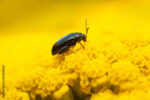
Research Summary Abstract
Collectively, managing coleopteran insects can be challenging because the adult and larval stages may both cause damage and sometimes occur on different hosts or on different plant parts. While organophosphates, pyrethroids, and neonicotinoids can provide good to excellent control of coleopteran insects, not all products work equally well in all situations. Treatments for borers are very different than treatments targeting white grubs. Developing newer classes of chemistry are important to reduce the environmental consequences and to minimize the development of resistance. Starting with the 2004 Annual Workshop, screening a number of products to manage coleopteran insects became one of the high priority projects for entomology. From 2005 through 2018, 74 products representing 49 different active ingredients were tested for management of adult and larval stages of coleopteran insects. In addition, 10 products representing 10 active ingredients were evaluated for lepidopteran clearwing borers in 2008 and 2009. These products represented both biological and chemical tools. Some products were already registered but more data were needed or they were considered standards to measure the level of efficacy achieved with other materials. Other products were in development but have not yet been registered with the EPA. While a number of coleopteran and lepidopteran species were tested, only enough experiments were able to be completed on the coleopteran species black vine weevil, Japanese beetle, oriental beetle, Sri Lankan weevil, and viburnum leaf beetles to recommend actions to register or amend labels for these pests.
